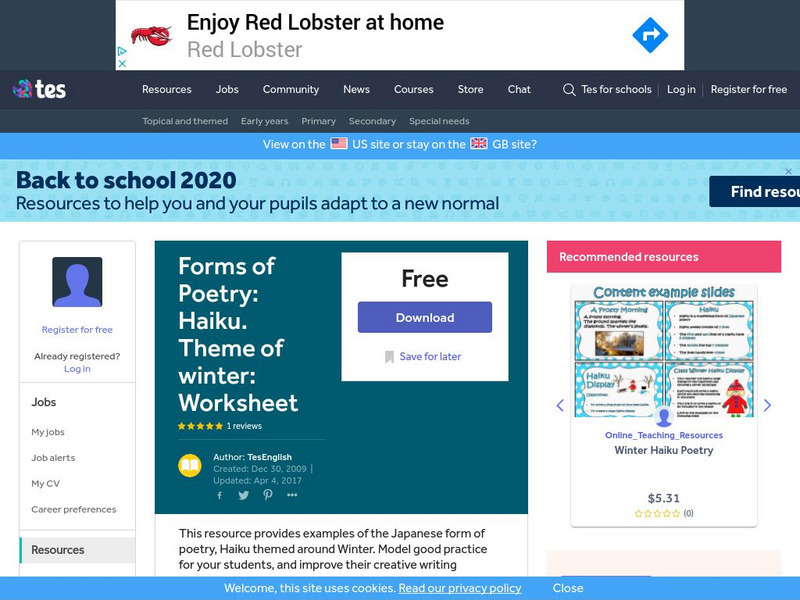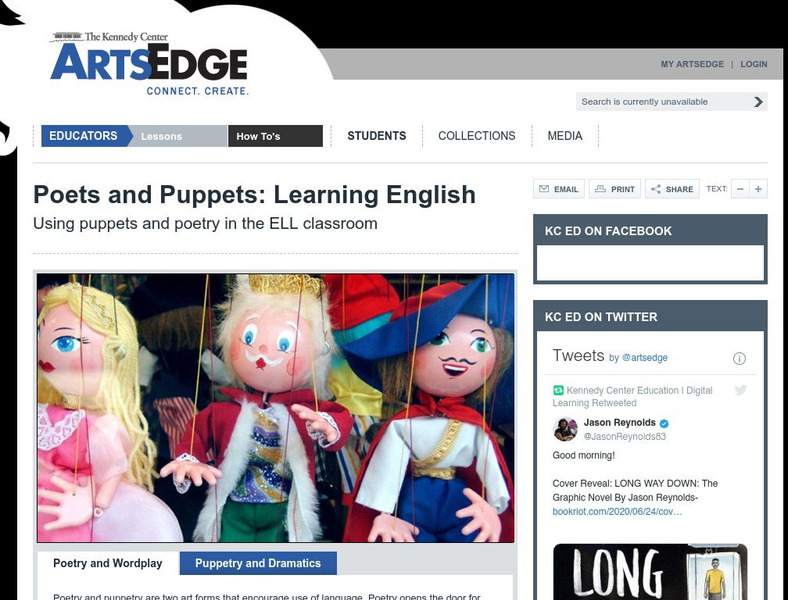Can Teach
Can Teach: How to Write a Name Poem
This site describes how a Name Poem is a good way to teach children to focus the influence that people (friends and family) around them have. Lesson plan indicated for 3rd grade and above.
Can Teach
Can Teach: How to Write a Cinquain
At the most basic level a cinquain is a five line poem or stanza. Here are two variations. Lesson plan indicated for 1st grade and above.
Writing Fix
Writing Fix: Serendipitous Personification for Poems
An explanation of personification and how it is used in poetry followed by a personification maker. Students push the buttons to create a personification and then write a poem that uses and expands on it.
A to Z Teacher Stuff
Ato Zteacherstuff: Dramatics With the Teaching of Poetry
This site from atozteacherstuff.com provides a instructional activity to help students develop an appreciation for poetry. This site will also will help create meaning from poetry.
Alabama Learning Exchange
Alex: Let's Write a Cinquain
During this instructional activity, third grade students will navigate the Internet to learn about cinquains. They will use their new knowledge to create their own cinquains while learning important word processing skills.
Can Teach
Can Teach: Writing a Bio Poem
This site describes how a Bio poem can be used to teach students to focus on the characteristics of a person or an animal, anything or anyone really. It requires the student to put themselves in the subject's shoes. Lesson plan indicated...
ReadWriteThink
Read Write Think: Seasonal Haiku
This site is a three-part lesson that teaches students how to write and depict seasonal imagery through haiku. Students study, listen to, and create original haiku on colored backgrounds.
ArtsNow
Arts Now Learning: Music Inspires Writing [Pdf]
In this lesson, young scholars will learn how music can be the impetus for creating original poetry and music.
Alabama Learning Exchange
Alex: Capturing a Moment in Time
This lesson allows the students to explore imagery poetry through the use of a digital camera. The students visualize an imagery poem then look at a painting that pays tribute to the poem. Then the students think of a moment in time...
ArtsNow
Arts Now Learning: Cultural Characters: Paul Revere [Pdf]
In this lesson, students explore the life of Paul Revere through the lens of a painting of the Midnight Run. Using the painting as a springboard, students write and enact a poem illustrating the event.
Alabama Learning Exchange
Alex: Learning About Cinquains
After reading/hearing Junie B. First Grader Cheater Pants by Barbara Park and discussing the concepts of cheating, following directions, and the genre of poetry, learners will write cinquains and will publish a class booklet.
TES Global
Tes: Forms of Poetry: Haiku. Theme of Winter: Worksheet
[Free Registration/Login Required] Students will learn about the form of a haiku. Students will read several examples of haikus and then write their own haikus about the topic of Christmas or New Year's Eve.
TES Global
Tes: Prose. Toad Rage
[Free Registration/Login Required] This resource features related activities connected to Morris Geitzman's book, Toad Rage. Students will read a fable, nonfiction reading, prose reading, and connected writing activities.
Writing Fix
Writing Fix: Noodle Alliteration
This lesson allows students an opportunity to explore the dictionary and thesaurus to write creative alliterations about pasta after reading Jack Prelutsky's poem, "Spaghetti, Spaghetti."
Writing Fix
Writing Fix: Memoirs About Photographs
This review discusses Looking Back, a memoir written by Lois Lowry. The song "Photograph", performed by Nickelback, and "In Color" by Jamey Johnson, are suggested as sources to assist with extending the students' understanding of memoir....
ReadWriteThink
Read Write Think: Reading, Writing, Haiku Hiking! Class Book of Picturesque Poems
Contains plans for five lessons about haiku using "One Leaf Rides the Wind" by Celeste Davidson Mannis as an introduction and model. In addition to objectives and standards, these instructional plans contain links to sites used in the...
ReadWriteThink
Read Write Think: Sports Poetry in Motion
This lesson plan enables students to study and understand the grace of motion involved in the movement of sports. Included in the lesson plan is an overview, practice, objectives, resources, preparation, and more.
ReadWriteThink
Read Write Think: Teaching Personification Through Poetry
This lesson plan examines the use of personification in the "great poets." Included in the lesson plan is an overview, practice, objectives, resources, preparation, and more.
John F. Kennedy Center
The Kennedy Center: Poets and Puppets: Learning English
Use these how-toos to help English Language Learners with speaking and writing. Using poetry and role playing with puppets unleashes creativity.
ReadWriteThink
Read Write Think: Wartime Poetry Working With Similes
Contains plans for four lessons that use photos and depictions of World War II to inspire similes to use in poems. In addition to objectives and standards, this instructional plan contains links to sites used in the lessons as well as...
University of Illinois
University of Illinois Extension: Character Education "I Am Me"
Excellent resource for empowering learners to become better learners. This lesson plan includes promoting students' understanding of themselves through self-expression, critical thinking skills, and creative writing and thinking skills...
PBS
Pbs: Mathline: Tessellations Wow! [Pdf]
An integrated geometry lesson on spatial sense in which students identify and use different shapes to create a tessellation. "Through a variety of modalities such as writing, music, art, poetry, and literature, students are introduced to...
John F. Kennedy Center
The Kennedy Center: Oceans: A Sensory Haiku
In this lesson plan, students use the ocean and their five senses as inspirations to create their own unique haikus. Lesson provides assessment criteria and a list of sources.
ReadWriteThink
Read Write Think: Composing Cinquain Poems With Basic Parts of Speech
Reinforce student understanding of parts of speech through the analysis of sample cinquain poems followed by the creation of original cinquains.
Other popular searches
- Writing Poetry Onomatopoeia
- Writing Poetry Third Grade
- Writing Poetry and Prose
- Creative Writing Poetry
- Writing Poetry Rhyming Poems
- Descriptive Writing/poetry
- Writing Poetry Unit
- Writing Poetry Lesson Plans
- Poetry Writing Workshop
- Writing Concrete Poetry
- Writing Poetry On
- Teaching Poetry Writing
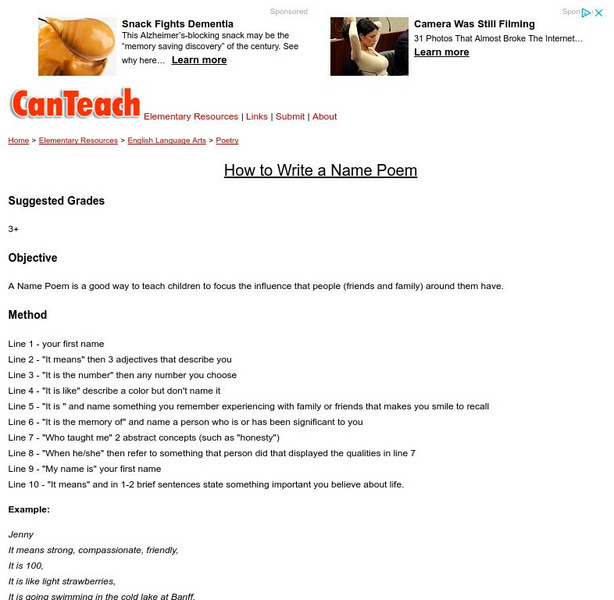

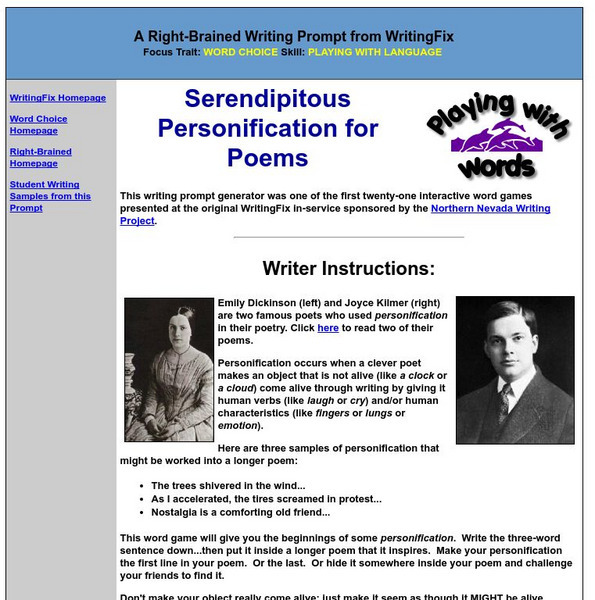
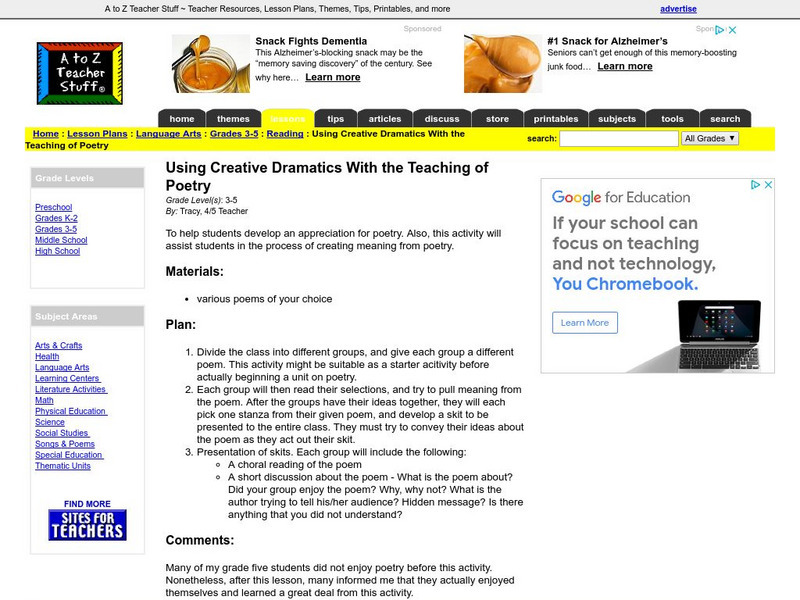



![Arts Now Learning: Music Inspires Writing [Pdf] Lesson Plan Arts Now Learning: Music Inspires Writing [Pdf] Lesson Plan](https://static.lp.lexp.cloud/images/attachment_defaults/resource/large/FPO-knovation.png)


